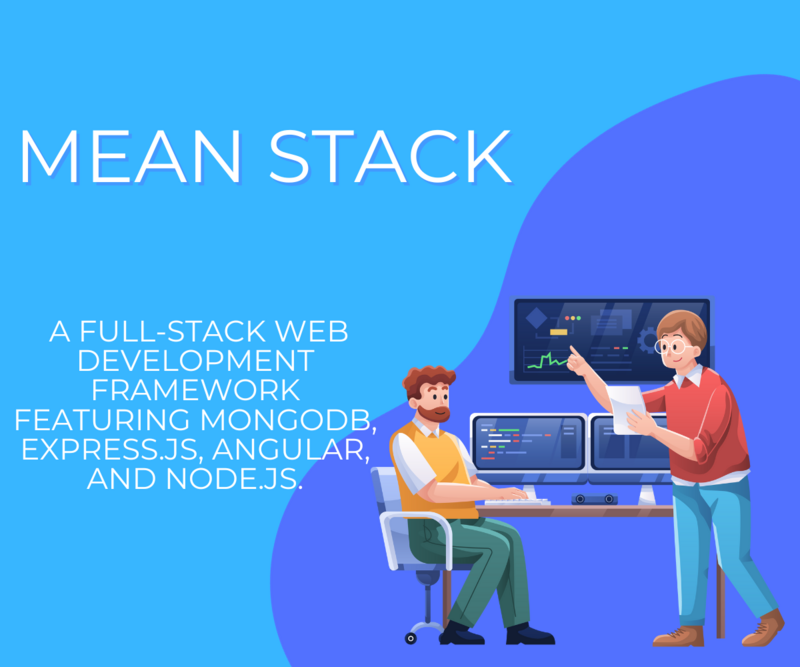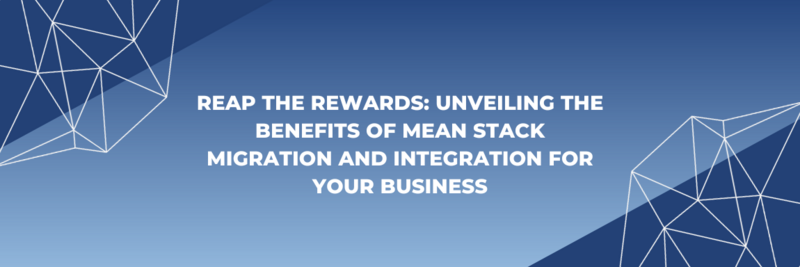In today's digital age, developing efficient and scalable web applications is crucial for businesses looking to stay competitive. MEAN stack development has emerged as a powerful solution, offering a full-stack JavaScript framework that combines four key technologies: MongoDB, Express.js, Angular, and Node.js. This blog post will delve into the uses of MEAN stack development across various industries, explore its technical aspects, and highlight its potential for custom development.
MEAN Stack Overview:
 MongoDB
MongoDB
As a NoSQL database, MongoDB offers flexibility and scalability, making it ideal for handling large volumes of unstructured data. Its document-oriented structure allows easy integration with JavaScript, making it a natural fit for MEAN stack development.
Express.js
Serving as a web application framework, Express.js provides a simple and minimalistic approach to building robust web applications. It enables developers to create APIs, handle routing, and manage middleware, making it a popular choice for server-side development within the MEAN stack.
Angular
Developed by Google, Angular is a powerful front-end framework for building dynamic and interactive user interfaces. It follows the Model-View-Controller (MVC) pattern, allowing developers to create responsive web applications easily.
Node.js
As a JavaScript runtime environment, Node.js enables server-side execution of JavaScript. It leverages an event-driven, non-blocking I/O model, making it highly scalable and efficient for handling concurrent requests. Node.js forms the backbone of MEAN stack development, facilitating seamless communication between the client and server.
Uses of MEAN Stack Development Across Industries:
E-commerce
MEAN stack development offers a robust platform for developing secure and scalable e-commerce applications. With features like real-time inventory management, personalized user experiences, and secure payment gateways, businesses can create seamless online shopping experiences for their customers.
Healthcare
The MEAN stack's flexibility and scalability are particularly valuable in the healthcare industry. Developers can create electronic health record systems, appointment scheduling applications, telemedicine platforms, and more. MEAN stack's real-time capabilities enable healthcare providers to deliver prompt and efficient patient care.
Social Networking
MEAN stack development can power social networking platforms, fostering online communities and enabling users to connect and interact. With its real-time capabilities, developers can create chat applications, news feeds, user profiles, and social sharing functionalities, providing engaging and dynamic user experiences.
Technical Aspects of MEAN Stack Development:
Single Language
One of the significant advantages of MEAN stack development is the use of a single programming language, JavaScript, throughout the entire stack. This streamlines the development process, reduces code complexity, and facilitates seamless collaboration between front-end and back-end developers.
Isomorphic Code
With the MEAN stack, developers can write isomorphic code, meaning the same code can be shared and executed on both the client and server sides. This eliminates the need for duplicating code and allows for faster development and easier maintenance.
RESTful APIs
The MEAN stack's architecture supports the development of RESTful APIs, enabling efficient data exchange between the client and server. This approach simplifies integration with external services and facilitates the development of mobile applications and third-party integrations.
Custom Development with MEAN Stack
MEAN stack development provides the flexibility to create custom solutions tailored to specific business requirements. With its modular architecture, developers can easily add or remove components based on project needs. This flexibility allows for rapid prototyping, iterative development, and seamless scalability as the application grows.
MEAN Stack Migration
MEAN stack migration involves transitioning an existing application or system to the MEAN stack framework. This process typically involves migrating data, redeveloping the application using the MEAN stack's technologies, and ensuring a smooth transition from the old system to the new one. Here are some key aspects of MEAN stack migration:
Assessment
The first step in MEAN stack migration is assessing the existing system to identify its strengths, weaknesses, and potential migration challenges. This includes analyzing the application's architecture, dependencies, data models, and business logic.
Planning
Once the assessment is complete, a migration plan is developed. This plan outlines the migration strategy, including the migration order, data migration approach, and any necessary modifications to the existing codebase.
Data Migration
Data is a crucial component of any application. During MEAN stack migration, existing data from the old system must be transferred to the new MongoDB database. This process involves mapping the data structures and ensuring data integrity throughout the migration.
Redevelopment
With the data migration complete, the application is redeveloped using the MEAN stack technologies. This involves building the server-side components with Node.js and Express.js, implementing business logic, and developing the front end using Angular.
Testing and Deployment
Thorough testing ensures the migrated application functions correctly and meets the required performance standards. Once testing is complete, the application is deployed in a production environment, ready for use.
MEAN Stack Integration:
MEAN stack integration involves incorporating one or more MEAN stack components into an existing system or application. This process enables businesses to leverage the benefits of MEAN stack technologies while maintaining their existing infrastructure. Here are a few scenarios where MEAN stack integration is valuable:
API Development
MEAN stack's Express.js component can be integrated into an existing system to develop RESTful APIs. This allows seamless integration with third-party services, mobile applications, or other internal systems.
Real-time Functionality
By integrating Node.js into an existing system, businesses can add real-time capabilities, such as chat functionality or live data updates. Node.js' event-driven architecture enables efficient handling of concurrent requests, enhancing the user experience.
Single-Page Applications
Angular can be integrated into an existing system to develop dynamic and interactive single-page applications (SPAs). This allows businesses to modernize their user interfaces and provide a more engaging and responsive user experience.
Microservices Architecture
MEAN stack components can be integrated into a microservices architecture, where different components of an application are built and deployed independently. This enables scalability, flexibility, and easier maintenance of complex systems.
Benefits of MEAN Stack Migration and Integration:

Streamlined Development
MEAN stack migration and integration leverage a unified JavaScript codebase, simplifying the development process and fostering collaboration between front-end and back-end developers.
Scalability and Performance
MEAN stack technologies, such as Node.js, offer scalability and high-performance capabilities, allowing applications to handle concurrent users and process requests efficiently.
Flexibility and Modularity
MEAN stack's modular architecture enables businesses to integrate specific components as needed, providing flexibility and customization options to suit their requirements.
Cost and Time Efficiency
MEAN stack migration and integration can save businesses time and resources by leveraging existing infrastructure.
MEAN Stack Migration and Integration
Understand the current system
Before starting the MEAN stack migration, it is important to understand the existing system. Assess what technologies are currently being used and how they will fit into the new architecture.
Create a plan
Create a well-detailed plan outlining what parts of the application need to be upgraded, refactored, or rewritten, emphasizing backward compatibility. Determine how much effort and cost would be required for each process step, and include technical and nontechnical considerations.
Choose a front-end framework
Depending on the application's size, complexity, or desired feature settings, choose the appropriate front-end web development technology, such as React or AngularJS, for better performance and responsiveness from your MEAN Stack migration and integration process.
Consider user authentication
When migrating to a MEAN stack infrastructure, it is essential to decide whether user authentication will be handled internally or externally via an existing third-party service provider like Amazon Cognito or Auth0, for example. Having this map out in advance will ensure smoother integration during deployment times – avoiding potentially costly delays in product go-live timeframes.
Utilize modern databases
One of the most relevant challenges of modern web application development is scaling databases appropriately over multiple concurrent users while improving performance and availability; using MongoDB allows organizations to scale faster than traditional relational databases such as MySQL due to its NoSQL capability, with documents allowing fewer custom SQL coding requirements upfront.
DevOps pipelines
Properly leverage DevOps pipelines across different stages, including development, testing, deployment, and monitoring, by setting up automated triggers with services such as GitHub Actions or Jenkins CI, along with leveraging infrastructure-as-code solutions like Terraform or AWS Cloud Formation Templates, which enable better control over environment setup while minimizing opportunities for human error or misconfiguration errors upfront whenever possible during deployments.
Security measures
Ensure proper security measures at every layer during this process by following best practices such as restricting unauthorized access to sessions, implementing TLS encryption standards at nodes, and ensuring thorough logging capabilities when needed depending on the sensitivity of the stored data, such as usernames, passphrases, etc. All these steps taken collectively will allow for efficient migration and integration efforts without compromising key deliverables expected by stakeholders within stated deadlines agreed upon upfront!
MEAN Stack Management & Maintenance Services
MEAN Stack management and maintenance services refer to the ongoing support and upkeep of web applications built using the MEAN stack. These services typically include:
Security Monitoring Services
The most important thing you can do to keep your MEAN stack safe from threats is to offer comprehensive security monitoring services for networks, applications, and databases. This should include vulnerability scanning, patch management, and continuous auditing of all endpoints.
Support for Middleware and Frameworks
Nearly every application has components and frameworks with different versions that must be managed and updated. From system libraries to the MEAN stack itself, the right IT professional will keep track of all dependency versions and perform any required upgrades or maintenance as needed.
Performance Optimization and Troubleshooting
As you add more features to your MEAN-stack-based applications, they can start to slow down or even break. An experienced IT professional can help you optimize your system's server resources with tools like APM (Application Performance Management) to ensure a smooth operation with minimal downtime.
Database Administration Services
From designing complex database schemas to backups and assessments, regular database administration is necessary for peak scalability and performance for a MEAN stack application since all component layers work together.
Infrastructure Management Services
Ensuring nonstop availability of the resources used by your web application requires experienced professionals familiar with setting up physical and virtual network infrastructure on top of cloud platforms, such as AWS, Azure, etc., that your MEAN stack might be running on.
Load Balancing Services
Due to its distributed architecture, the number of requests that a MEAN stack can handle gets multiplied, which puts incredible strain on the servers and components within it. At peak times, load balancing becomes mandatory to keep latency low without sacrificing performance.
Cloud Backup Services
Migrating an existing app architecture, such as the MEAN stack, onto cloud systems requires expertise that considers backup and disaster recovery services since these critical enterprise components must be done away with help during migrations or upgrades.
Newsletter to recieve
our latest company updates
Comment